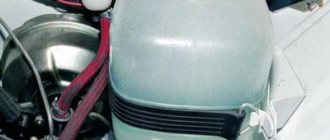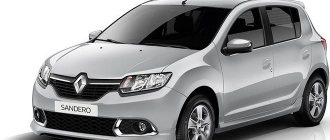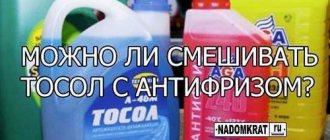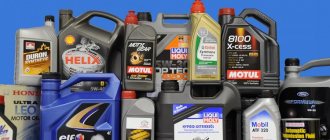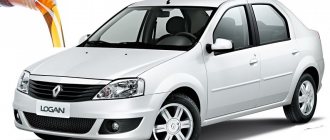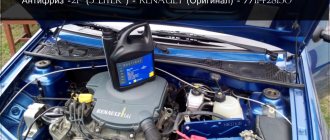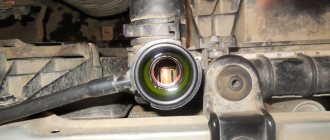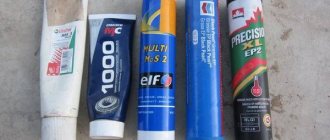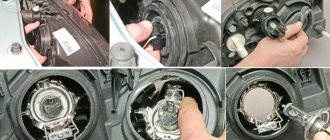The use of a liquid cooling system in cars makes it possible to maintain the engine temperature within certain limits in order to provide the most optimal conditions for the processes occurring inside the power plant.
But this system structurally complicates the engine design; in addition, it requires the presence of another engine working fluid - coolant. In this case, the liquid must circulate to remove heat from the hottest engine elements to ensure that the temperature is maintained within the specified limits. And since the cooling system is closed, the liquid must transfer the heat removed further, in the case of a car, to the environment, so that it can again pick up some of the heat. Essentially, the liquid in the cooling system is just a “transporter” of heat, but it is more efficient than the air that cools an air-cooled engine.
Why doesn't water work?
Initially, ordinary water was used as a cooling liquid for the power plant. It performed its functions quite effectively, but due to a number of negative qualities, it was practically abandoned.
The first and one of the most unfavorable factors of water as a cooling liquid is its low freezing threshold. Already at 0°C, water begins to crystallize. As the temperature decreases, water turns into a solid state - ice, and the transition is accompanied by an expansion of volume. As a result, frozen water in the cylinder block can rupture the cooling jacket, damage pipelines and destroy radiator tubes.
The second negative factor of water is its ability to deposit scale inside the cooling system, which reduces heat transfer and reduces cooling efficiency. In addition, water can react with the metal, which can cause corrosion to appear at the point of contact.
Cylinder block corrosion
Another significant negative quality of water is the boiling temperature threshold. Officially, the boiling point of water is 100°C. But this indicator depends on many factors, one of which is the chemical composition.
Often the boiling point of water is below the set level; in some cases, the boiling point can be 92-95°C. If we take into account that for many cars the optimal engine temperature is considered to be 87-92°C, then in such engines the water will work on the verge of boiling, and at the slightest increase in temperature it will turn into a gaseous state, stopping its main function - drainage heat.
Because of these negative qualities, water has almost been abandoned as a coolant. Although it is sometimes used in agricultural machinery engines, many rules must be followed.
Properties and characteristics of coolant
The freezing point of coolant depends on the ratio of ethylene glycol and water. Pure ethylene glycol “freezes” already at -12.3°C. The lowest possible freezing point, -75°C, can be achieved by mixing 75% ethylene glycol and 25% water. The most common coolants consist of 35...50% water. A mixture containing 35% water begins to crystallize at - 650C, and 50% at - 400C.
The properties of the coolant depend on the quality and purity of the raw materials. The best antifreezes are made from chemically pure (99.9) ethylene glycol, with additives without foreign impurities. Often, unscrupulous manufacturers use a cheap surrogate diethylene glycol, a purification product of the main raw materials.
Cheap antifreeze cannot be made from expensive components. If you purchase “on occasion” a very inexpensive canister of bright liquid, rest assured that the product in it is chemically unstable, after some time it will lose or change color, and precipitation will begin to fall out of it. You will have to pay twice - for flushing the system and for replacing the coolant.
There is no uniform standard for antifreeze. Each country has its own regulations, for example:
- In the USA - ASTM D 3306;
- In the UK - BS 6580;
- In France - AFNOR NF R15-601, etc.
In Russia, GOST 28084-89 “Low-freezing cooling liquids” is in force. According to this document, which has not changed for more than 30 years, coolants are characterized by the following basic properties:
- Freezing temperature (beginning of crystallization) . GOST specifies OZh-40 and OZh-65 with the corresponding freezing temperature. This indicator may be different for foreign-made antifreezes.
- Boiling temperature . At normal atmospheric pressure 110-135°C. In a closed cooling system, the pressure increases by 1.5-3 times, and the boiling point of liquids changes accordingly.
- Foamability . When coolant circulates in a working system, foam does not form. This characteristic was important with the then filling technology on the VAZ conveyor.
- Anti-corrosion properties . GOST 1989 was written for coolants whose additives contained phosphates, borates, amines and nitrites. Such coolants were used mainly in the 60-90s of the last century. Modern requirements allow the use of traditional coolants only in older models, and only if silicate compounds are used as inhibitors.
- Impact on rubber elements . The coolant should protect the rubber from cracking and delamination. Inexorable technological progress has long led to the replacement of rubber hoses with products made from synthetic rubbers and polymer materials.
We have to admit that compliance with GOST does not indicate the quality or possibility of using coolant.
The main criterion can be considered the permission of the car manufacturer to use this coolant for a specific model, indicated in the passport or in the operation and repair document.
Types of cooling fluids
To replace water in internal combustion engines, they began to use special liquids - antifreeze, but water has not gone away. After all, in essence, antifreeze is a mixture of water with materials that change its properties, primarily lowering the freezing point. Such materials can be inorganic salts (sodium and calcium chloride), alcohols, glycerin, glycols, carbitols.
Aqueous solutions of glycols are most widely used in internal combustion engines. The composition and use of coolants for car power plants are almost identical; only special additives to them can differ.
Glycol-based antifreezes are optimal for use in cars.
An interesting fact is that the best antifreeze is considered to be a 40% solution of ethyl alcohol, that is, ordinary vodka.
But alcohol vapors are flammable, so using such antifreeze on cars is unsafe.
As for the composition of glycol antifreezes, the main elements are water and glycol, and additives include corrosion inhibitors, anti-cavitation and anti-foam additives, as well as dyes. Ethylene glycol is most commonly used, but propylene glycol-based coolant can also be found.
The best antifreezes for leading auto brands
In addition to the high-quality coolants mentioned above, global automakers also use their own brands of antifreeze. In particular, cars produced in Russia and Europe are filled with the following antifreezes:
- Ford Super Plus Premium LLC - with a range from -37 to 120°C. Average price 1500 RUR / 5 l. Carboxylate.
Source – lapi.planetavto.ru
- Hyundai Crown LLC A-110 – with a range from –40 to 110°C. Average price 1400 RUR / 5 l. Hybrid.
Source – avatars.mds.yandex.net
- KIA Crown LLC A-110 – with a range from –40 to 110°C. Average price 1400 RUR / 5 l. Hybrid. 100% similar to the previous one, only with the KIA emblem on the bottle sticker.
Source – www.oilbay.ru
- Lada G11 (hybrid) or G12 (carboxylate) - with a range from –40 to 110°C. Average price 1100 RUR / 5 l.
Source – lapi.planetavto.ru
- Toyota Long Life Coolant – with a range from –40 to 130°C. Average price 2000 RUR / 5 l. Carboxylate.
Source – avatars.mds.yandex.net
- Renault Glaceol RX – with a range from –37 to 110°C. Average price 1800 RUR / 5 l. Carboxylate.
Source – maslenka18.ru
Original coolants with automaker labels are produced by the same enterprises that produce conventional antifreeze. For example, Hyundai Crown LLC A-110 and KIA Crown LLC A-110 are produced in the Klimovsk microdistrict of the city of Podolsk, Moscow region.
Positive properties of antifreeze
Let's go through the main positive qualities of glycol antifreeze:
- lower freezing point than water (this indicator depends on the percentage of glycols in the aqueous solution);
- glycol-based antifreezes have a significantly lower degree of expansion when freezing (Therefore, even at very low temperatures, when the solution crystallizes, the possibility of damage to engine components is much lower than when using water);
- the boiling point of the glycol solution is over 110°C (also depends on the percentage ratio of glycol and water);
- glycols contain substances that provide lubrication of system elements;
About the components that make up the coolant
It is known that all antifreezes for cars have different colors. They may well have red or green shades. However, their compositions look something like this:
- the main substance is usually propylene or ethylene glycol;
- distilled water - its share is very small;
- dye - the appearance of antifreeze depends on it;
- a variety of special additives that play a key role in this whole story.
Antifreeze base
Ethylene glycol antifreezes are the most common due to the low cost of their production. Their main disadvantage is high toxicity. They can cause death if they enter the human body. A particular danger in using ethylene glycol lies in the taste of such antifreeze - it has a sweet taste, so such liquid should be stored in places inaccessible to children.
Ethylene glycol is a transparent liquid with a yellowish tint and moderate viscosity. This liquid has a very high boiling point - +197°C. But it is interesting that the crystallization temperature, that is, freezing, is not so low, only -11.5 ° C. But when mixing it with water, the boiling point decreases, but crystallization occurs at a lower threshold. Thus, a solution with a 40% content already freezes at -25°C, and a 50% solution freezes at -38°C. The most resistant to low temperatures is a mixture with a glycol content of 66.7%. This solution begins to crystallize at -75°C.
Propylene glycol liquids are identical in properties to ethylene glycol, but they are less toxic, and their production is much more expensive, so they are less common.
How to check the coolant level
If we are talking about simply adding antifreeze, then it is important to follow safety precautions. It is known that the operating temperature of the engine can be very high, so you should allow it to cool before checking the fluid. This is also important because hot antifreeze circulates in the system, and even a specialist will not be able to estimate its exact amount under such conditions. As a rule, the best option is to check after overnight parking - this way the readings will be as correct as possible. There are two marks on the expansion tank indicating extreme levels of antifreeze. It's good if you manage to maintain average performance. An important point: if you decide to add water rather than coolant, it is better to use a distilled product.
Corrosion inhibitors in antifreeze
Now on to the additives used in car coolants. One of the most important additives is corrosion inhibitors. This type of additive, as the name implies, is designed to prevent the appearance of corrosion spots inside the cooling system.
Nowadays several types of such liquid additives are used and each of them has its own designation.
The first are additives, which are called traditional, since they were the first to be used in antifreeze. Liquids with this type of inhibitor have no additional designation.
Traditional inhibitors consist of inorganic substances - silicates, phosphates, nitrites, borates, as well as their compounds. Such additives form a thin protective layer over the entire internal surface of the system, preventing direct contact of the liquid with the metal.
At the moment, liquid manufacturers are trying to abandon this type of inhibitors. The reason for this is their short service life - no more than two years. An additional negative quality is their poor tolerance to high temperatures; they begin to break down at temperatures above +105°C.
The second type of corrosion inhibitors that are used in coolants are carbon-based organic substances. Liquids with such additives are called carboxylate antifreezes, their designations are G12, G12+.
The peculiarity of such inhibitors is that they do not form a protective layer over the entire surface. Such inhibitors chemically interact with the source of corrosion. As a result of the interaction, a protective layer is formed on top of this source, without affecting the surface without corrosion.
A feature of this type of inhibitors is their long service life - more than 5 years, while they are impervious to high temperatures.
The third type of inhibitor additives is hybrid. They include both carboxylate elements and traditional inorganic ones. Interestingly, based on the country of origin, you can find out what inorganic elements the hybrid inhibitor contains. Thus, European manufacturers use silicates, American manufacturers use nitrites, Japanese manufacturers use phosphates.
The service life of inhibitors is longer than traditional ones, but they are inferior to carboxyl additives - up to 5 years.
Recently, another type of inhibitors has appeared - also hybrid, but they are based on organic materials, and mineral substances are added to them. This type of inhibitors has not yet been fully defined, so they appear everywhere as lobrids. Antifreezes with such additives are designated G12++, G13.
It should be noted that this classification is not entirely generally accepted; it was introduced into use by the German concern VAG, but so far nothing else has been invented, and everyone uses this designation.
What to choose – concentrate or ready-made liquid?
The same thing - there is no particular difference what to use - concentrated or ready-made antifreeze liquid . It’s just that, in the first case, you will also need to buy distilled water (regular water will not work).
And the concentrate can be diluted in accordance with the climatic characteristics of the area and the universal principle: the higher the low-temperature resistance of the antifreeze, the lower its resistance to boiling.
Simply put, if you live not in the Far North, but in the South of Russia, where there are no extreme frosts and hot summers, you can add more distilled water. The resulting coolant will not freeze in winter and will be more resistant to very high temperatures in mid-summer.
If the machine is operated in the harsh conditions of the North, more concentrate must be added and less water.
Other additives, dyes
Anti-cavitation and anti-foam additives are needed to maintain the fluid in a state that will ensure maximum heat removal. After all, cavitation is the formation of air bubbles in a liquid, which in the case of antifreeze will only cause harm. The presence of foam is also not desirable.
Dyes in antifreeze perform several functions. It makes it easier to find out the level in the system. Car expansion tanks are often made of white plastic. The level of a colorless liquid in such a tank would be invisible, but one that has a certain shade is easily visible.
Another property of the dye is an indicator of suitability for further use. Over time, the antifreeze in the system will develop its additives, causing the liquid itself to change color. A change in color will signal that the liquid has exhausted its resource.
As for the shades of antifreeze, they can be very diverse. Our most common shades are blue and red. Moreover, the temperature stability of the liquid is often tied to color. Thus, antifreeze with a blue tint most often has a freezing threshold of -40°C, with a red tint -60°C. However, this is not always the case; you can also purchase a liquid with a red tint, whose temperature threshold is -40 degrees.
But these are not all the shades that antifreeze can have. There are also liquids with a yellow, green, or orange tint. In this matter, everything depends on the manufacturer. As for the temperature stability of antifreeze, you should not rely only on color. This indicator may differ for different manufacturers, despite the fact that the color of the liquid may be the same.
What is the difference between antifreeze and antifreeze?
During operation, antifreeze performs the function of lubricating moving particles, protecting against corrosion, removing heat, preventing deposits, etc. In cold weather, it provides heating for the interior. The properties are lost over time and the product must be replaced with a new one to avoid wear of components and overheating of the engine.
Many people confuse antifreeze and antifreeze; the difference is unclear to them. Antifreeze is a type of antifreeze - already prepared for use as a liquid subject to classification (usually G11).
A few words about “Tosol”
Now about “Antifreeze”. Almost all of the coolants we produce are called this way. In fact, “Tosol” is just one type of antifreeze.
This liquid was developed at the Research Institute of Organic Chemistry and Technologies, Department of Organic Synthesis Technology. The abbreviation of this department formed the basis of the word for liquid. The prefix -Ol in the name, according to one version, means alcohol. Hence the name – “Tosol”.
"Tosol" is an ethylene glycol solution with the addition of a traditional inhibitor. It is still produced now, and in two types - “Tosol 40” and “Tosol 65”. The digital designation indicates the freezing point of a given liquid.
Additionally, they differ in color - “Tosol 40” has a blue tint, while the more frost-resistant liquid has a red tint.
In general, “Tosol,” developed in the USSR, has long been outdated, but the very name of the coolant is so firmly rooted in the vocabulary that it is applicable to all liquids for the cooling system.
Coolant functions
Before choosing a specific type of antifreeze, you should pay attention to the functions that the liquid performs. Everything here is not as simple as it seems. The list is extensive:
- direct cooling of the power unit in order to maintain optimal operating temperature and prevent excessive wear of key elements;
- protection of metal parts of the cooling system from the formation of rust and scale, as well as the occurrence of cavitation - water hammer;
- Pump lubrication to extend service life and maintain efficient operation.
Features of using liquid
Coolant is now sold in two types - a ready-made diluted mixture, and ethylene glycol concentrate, which must be diluted before use.
There are no particular problems with using a ready-made solution. Liquid is purchased in the quantity specified in the technical documentation for the car in the section on filling containers. The type of liquid used is also indicated there. In this matter, it is better not to experiment, but to purchase the liquid recommended by the car manufacturer.
Next, the purchased liquid must be poured into the system through a radiator or expansion tank, after draining the used antifreeze.
Recommendations for choosing antifreeze
It is important to consider that antifreeze, like any liquid, tends to expand when heated, so you should not fill the system so that its level in the tank is “full.” Usually the tank has a maximum fill mark on the tank; if there is none, it should not be filled more than halfway. It is worth saying that the level in the tank must be maintained after the system is completely filled.
If you purchased a concentrate, then before filling it will need to be diluted with distilled water. You cannot use the concentrate without first diluting it with water; do not forget that the crystallization temperature of pure ethylene glycol is not that low.
Before breeding, you need to decide on the proportions. The optimal proportion is considered to be 1 to 1. Such a mixture will have a freezing point of -40°C, which is quite enough for most of our latitudes.
The frequency of antifreeze replacement largely depends on the chemical composition and additives. Some fluids can last 250 thousand km. In general, it is believed that the fluid life is 100-200 thousand km.
You should also not completely trust manufacturers that their liquid is capable of working out a significant resource. After all, this resource is indicated for liquid poured into a completely clean engine. And when replacing the fluid, a part of the used fluid always remains in the engine, which, when mixed with the new one, reduces its properties and affects its service life.
Is it possible to mix antifreeze with antifreeze?
You can mix liquids of different compositions if this is prescribed in the technical specifications and standards of the automakers. If products have different technical standards, they may negatively affect their antifreeze properties. Even the same color does not guarantee the identical composition of liquids.
Prepared antifreezes contain ethylene glycol or propylene glycol, additives of organic or mineral origin and water in the required proportions. Adding pure antifreeze results in complete loss of cooling or protective properties. If the liquid level has dropped, you can add regular distilled water.
You may also be interested
Antifreeze Sintec G11 / Euro G11 green: description and properties
The correct choice of this fluid determines how long you can use the car without replacing the cooler and how well it will protect the car. SINTEC G11 Euro is a product that meets modern requirements.
Antifreeze Sintec Lux OEM G12
SINTEC LUX G12 antifreeze is a representative of the class of red carboxylate coolants. It has a high-quality composition, an affordable price and good technical parameters. The very technology of its manufacture is that additional corrosion inhibitors are added to this base liquid. Read more in the article from the experts on our site.
avtoexperts.ru
Coolant plays an important role in the operation of a car. What it is intended for, what it consists of, how often it should be changed and which fluid to choose for a particular model - we will answer these and other questions most frequently asked by our readers in our article today.
What is coolant used for?
The main function of the coolant is to reduce the thermal load on the components and parts of the internal combustion engine installed in the car. It circulates in a closed loop, coming into contact with the walls of the engine cylinders (in which the temperature of the burned fuel reaches several thousand degrees Celsius) through the so-called “cooling jacket” of the power plant (a special cavity), heats up and removes excess heat from the cylinder block.
engine cooling system
In the engine cooling system, the working fluid flows through two circuits - small and large, periodically heating up (at the working surfaces of the engine) and cooling (in the radiator). A centrifugal pump is responsible for the circulation of coolant in the system, and a thermostat is responsible for redirecting it from a large circuit to a small one (when the engine warms up), depending on the operating temperature of the engine.
The expansion tank plays an important role in the engine cooling system: it contains a reserve of “coolant”, through its valve the excess pressure of the coolant is regulated, which allows the engine to operate at higher temperatures, preventing it from boiling.
Expansion tank
What does coolant consist of?
Two types of liquids are used to cool the engine: distilled water and antifreeze. Water is the cheapest, non-toxic, highest specific heat capacity (ability to absorb heat per unit weight) and greatest cooling liquid. Antifreezes are chemically complex substances that have a high boiling point and are not susceptible to freezing at critically low temperatures (from -40°C to -70°C).
Distilled water, antifreeze, antifreeze
Water is not used in the engine cooling system of modern cars because it is impractical: it freezes already at 0°C, expanding up to 10% in volume and turning into ice crystals. Accordingly, this “cooler” will no longer be able to perform its main function, removing heat from the engine, in winter; moreover, ice crystals formed in the engine cooling system can harm the components and parts of the power unit, leading to the so-called “defrosting” » engine - that is, the destruction of cylinder blocks and cylinder heads. Therefore, today automakers prefer antifreezes that do not have the inherent disadvantages of water.
Antifreeze contains two main elements - water and polyhydric alcohols, which have a high ability to expand when heated, one of the key characteristics of a coolant. In addition to water and polyhydric alcohols, antifreeze contains a variety of additives that improve the performance characteristics of the coolant: suppressing the formation of rust on metal surfaces, foaming when reaching high temperatures, destruction of the surfaces of rubber parts, the formation of steam condensate, and others. Another element of antifreeze is a dye, which plays the role of a marker - if the liquid changes color during operation, then it is time to replace it.
Based on the composition of alcohols, all antifreezes are divided into two types: ethylene glycol and propylene glycol.
Ethylene glycol coolants contain ethylene glycol - a polyhydric alcohol with a sweetish odor, yellow color, whose density at +20°C is 1.112-1.113 g/cm³, boiling point - 197°C, and freezing point -11.5°C. Depending on the operating conditions for which the ethylene glycol-based “cooler” is intended, it is diluted with water in the following proportions: 1:1, 1:2 or 2:3. The higher the content of ethylene glycol in such a mixture, the greater its resistance to freezing and boiling.
Propylene glycol antifreezes contain propylene glycol, a polyhydric alcohol, which is very similar in chemical properties to ethylene glycol, but has less toxicity and a higher degree of kinematic viscosity. Its last property can be considered a disadvantage, since when the power unit is exposed to external low temperatures, the circulation speed of such a “coolant” through the engine cooling system drops, and the liquid performs its functions worse.
Antifreezes also differ in the chemical composition of their additives - they are divided into four types: traditional, carboxylate, hybrid and lobrid.
Traditional additives, used mainly in cars produced in Europe, North America and a number of Asian countries (Japan, South Korea) before 2000, contain corrosion inhibitors from inorganic elements - phosphates, nitrates, borates, and so on. They were no longer used for cooling engines for several reasons: a relatively short service life (up to 2 years), low boiling point (up to 105°C). During operation, traditional additives, decomposing, covered the working surfaces with a layer of substances they contained, which led to deterioration in the cooling of components and parts of the power plant, destruction of the elements of the centrifugal pump, and clogging of the line of the machine's cooling system.
Application: traditional antifreeze (Tosol) is used today in domestically produced cars (VAZ, UAZ, GAZ).
Carboxylate additives containing organic acids (carboxylates) are the most effective in slowing down corrosion. They are able to target potential areas of corrosion and cavitation (formation of steam condensate), covering problem areas with a protective layer of no more than 1 micron, which allows for more efficient engine cooling. The service life of such additives is from five years or more, depending on operating conditions.
Application: carboxylate antifreezes are used in cars of the brands Fiat, Ford, KIA, Hyundai, Renault and others. Hybrid additives contain inorganic (silicates, nitrites or phosphates) and organic (carboxylates) substances. The cumulative effect of these mixtures on the sources of corrosion and steam condensate is higher than that of traditional additives, but due to the presence of non-limiting additives, they have the same, but less pronounced, disadvantages as “pure” silicate, phosphate and nitrite inhibitors. The service life of hybrid additives is from three to five years.
Application: hybrid antifreezes are used in cars of the brands Chrysler, Mercedes-Benz, BMW.
Lobrid additives are the newest type of corrosion and steam condensate suppressors, which can be classified as a hybrid subtype. Their peculiarity is the distribution of organic (90% carboxylates) and inorganic (10% silicates) substances in a mixture, which leads to improved technical characteristics of such antifreezes compared to hybrid ones.
Application: used in cars of the brands Peugeot, Citroen, Volkswagen, Skoda, Seat.
Volkswagen antifreeze labeling
The Volkswagen concern has developed its own coolant approval marking for carboxylate, hybrid and lobrid antifreezes, which is used by many today. Thus, carboxylate antifreezes are marked G12 and G12+ (corresponding to the VW TL 774-D/VW TL 774-F specification), hybrid – G11 (corresponding to the VW TL 774-C specification), lobrid – G12++, G13 (corresponding to the VW TL 774- specification G).
Original Volkswagen antifreeze
A feature of these specifications is the ban on the use of borates, nitrites, amines, phosphates and silicates in coolants (except for G11 and G12++, where the content of this substance is allowed within the limits of up to 680 mg/l and up to 500 mg/l, respectively). Volkswagen allowed the use of G11 antifreeze in its cars produced before 1996, G12 and G12+ in models produced from 1997 to 2008. Antifreeze liquids G12++ and G13 are used today in cooling systems of automobile engines produced by the concern since 2008.
Volkswagen carefully ensures that their tolerances are met by antifreeze manufacturers, who label their products in accordance with specifications G. If a coolant labeled, for example, G12+, contains at least one of the prohibited substances, then such antifreeze does not meet Volkswagen standards and can be considered a fake, since such an “anti-freeze” will not perform all functions and may “grow old” prematurely and cause harm to the engine.
What is the difference between antifreeze and antifreeze?
There cannot be any difference here, since the “Tosol” familiar to Russian car enthusiasts is the same antifreeze that belongs to traditional coolants. It contains ethylene glycol, water and inorganic additives. There are, for example, “Tosol 40” and “Tosol 65”, the first is blue, the second is red. “Tosol 40” is designed for operation at temperatures not lower than -40°C, and “Tosol 65” is designed for operation of non-freezing coolant at temperatures not lower than -65°C.
Is it possible to mix coolants of different compositions?
As with motor oils and transmission fluids, mixing coolants of different types and classes is not recommended due to differences in their chemical compositions. Thus, when mixing carboxylate and traditional additives, their chemicals may precipitate, which will lead to clogging of the cooling system. Even if this does not happen, additives with different chemical compositions may react, as a result of which their beneficial properties are significantly weakened.
Advice: if it is not possible to replenish the coolant supply immediately, it is better to add distilled water to the expansion tank of the cooling system.
What is the time frame for replacing coolant?
Replacement of the working fluid in the cooling system is carried out in three cases: planned, ahead of schedule and in an emergency.
It is planned to replace the coolant depending on the timing established by the car manufacturer. This information can be found in the instruction manuals for each specific model. Let us repeat: antifreezes with traditional additives are changed every two years, coolants with carboxylate additives - after five to seven years, coolants with hybrid additives - after three to five years, antifreezes with lobrid additives - after five to six years.
After these periods, the performance characteristics of coolants change: they lose their ability to resist corrosion, begin to boil at relatively low temperatures, and are less able to remove heat from components and parts of power plants.
It is necessary to change the coolant ahead of schedule if a structural failure of the engine has occurred, for example, exhaust gases from a leaky cylinder block gasket began to enter the antifreeze, or if the cooling system depressurized and air entered it. The interaction of coolant with exhaust gases or air leads to the liquid prematurely losing its basic performance properties. You can understand that the cooling system is malfunctioning if you notice that the radiator fan starts turning on more often, jelly-like deposits have appeared on the walls of the expansion tank, or sediment has appeared in the tank (often found at an air temperature of -15°C).
Possible breakdown of the engine cooling system
Emergency situations during which the driver had to add water to the cooling system include a burst hose. The hose was changed, the missing amount of coolant was supplemented with water taken from the tap. What happens next? Ordinary tap water does not have the properties of distilled water, so its salt content is increased. These salts, interacting with the chemicals that make up the coolant, form a sediment that negatively affects the metal parts of the system - in other words, corrosion processes are activated. Precipitated substances impede the circulation of antifreeze in the system, which leads to improper heat removal from engine components, which may result in engine overheating. If you still had to fill the engine cooling system with tap water, then at the first opportunity, completely replace the “coolant”, having first flushed the system with distilled water.
What to do if the antifreeze needs to be completely changed
Let's say you decide to change the coolant yourself. To do this, you will first need to drain the used product. You should park the car on a relatively level area and cool the engine to avoid burns during operation. Next, you need to remove the crankcase protection, if necessary, and also prepare containers for processing. After draining the old fluid, you need to flush the system and pour new antifreeze in a thin stream. This is a fundamentally important point - if you pour it too actively, you can get unpleasant surprises in the form of air pockets formed. They can interfere with the operation of the cooling system.
You may be interested in: Boiling points of antifreezes of different colors
